This article is part of the 31 Days of Pinterest Hacks series. Find the main page for this series here.
With the influx of technology, handwriting (printing or cursive) is becoming a lost art. For children with disabilities, tapping or scrolling with one finger is often easier than holding a pencil and scribbling on paper, making handwriting almost obsolete in some situations.
Traditionally, handwriting is taught by tracing letters and then repeating them several times on one line. What does a child do if they cannot hold a pencil? This post will show you that handwriting does not have to be entirely replaced by technology (although it can!). Children can have success with this art in their own way.

There are many free handwriting worksheets pinned on Pinterest. Do not start with these just yet. Decide whether the child is ready for handwriting at all.
A word about the benefits of handwriting
You might ask yourself: If technology can help children with writing, why bother with handwriting?
The Wall Street Journal ran an article in 2010* that highlighted the research done on the brain concerning handwriting. The study showed that handwriting helps with memory, fine motor development, and idea composition.
If using technology is best for a child, never force handwriting. Read the tips below and try to apply some of them as a test to see where the child is at.
* How Handwriting Trains the Brain (The Wall Street Journal article)
Why handwriting may be a challenge for neurodivergent and disabled children
- Hand bones may not be fully developed in some children.**
- Children requiring support with visual-motor tasks may find holding writing tools a challenge.
- Children with low muscle tone or joint hypermobility may require extra support for gripping a writing tool and gliding the tool across a page.
** X-ray of Hand Bone Growth: Child to Adult (from Science Photo Library)
Suggestions for adaptations/modifications for teaching handwriting
- Readiness. Do not force handwriting if the child is not ready. Ask yourself where the child is developmentally, and be honest about their readiness for handwriting. If you begin too early, you may be causing more harm than good.*** Since so much is required before a child learns to handwrite, you want to work on those skills first (i.e., eye-hand coordination practice activities, pincer grasp development, using a tool in hand, etc.). Ask the child’s OT about the prerequisites for handwriting.
*** Handwriting Readiness: Locatives and Visual-motor Skills in the Kindergarten Year (study by Marr, Windsor, and Cermak)

You will find plenty of worksheets and workbooks with printing/cursive outlines. Check with the child’s OT to learn whether your child is ready to put pencil to paper.
- Strengthen the body. One of the prerequisites the child’s OT may share is that the proprioceptive system must be developed. Since writing requires using the hands and fine motor control through applying different pressures in the hand (including crossing the midline), the proprioceptive system needs to be strengthened. What exercises can the child’s OT offer to target fine motor skills?
- Provide trunk support. Provide adapted seating, as required. The trunk and lower body should be fully supported to tackle handwriting.
- Feel the strokes with the body. Before picking up a pencil, have the child practice the lines and shapes with their body. Painting, drawing, modelling, yarn play, cutting/ pasting, and shape practice are intermingled activities and can help not only build each of those other skills but the skill of handwriting as well. In the air, with a flashlight, stick, etc., you can have the child “draw” circles, lines up and down, lines side to side, a cross, a square, a triangle, etc. You can use workbooks intended for print practice as inspiration for drawing in the air, floor, wall, etc.
- Include verbal routines. Remember “Zoom, zoom, zoom” from painting activities? Why not continue that verbal routine with drawing side-to-side, and say, “Round, round, round” for the circle drawing, and “Up, down, Up, down” for vertical lines and so on?

A ribbon wand makes for a great extension of the arm. Work hand-over-hand (with consent) at first to get the child to “draw” the lines and shapes in the air.
The steps that follow the list above are more in-depth—depending on what the child can do. We can work one-on-one if you’d like to talk about books, materials, or how to find the right specialists. I can also support you in finding alternatives to handwriting.

0 Comments